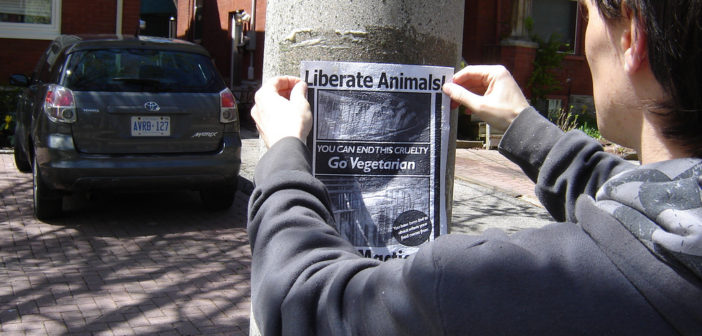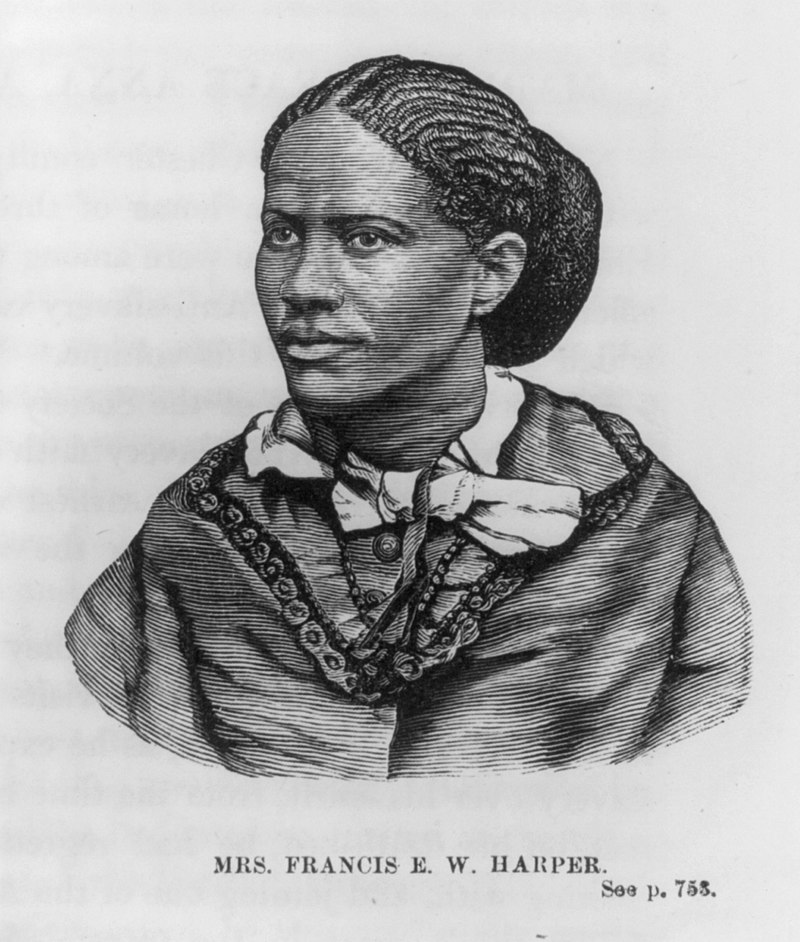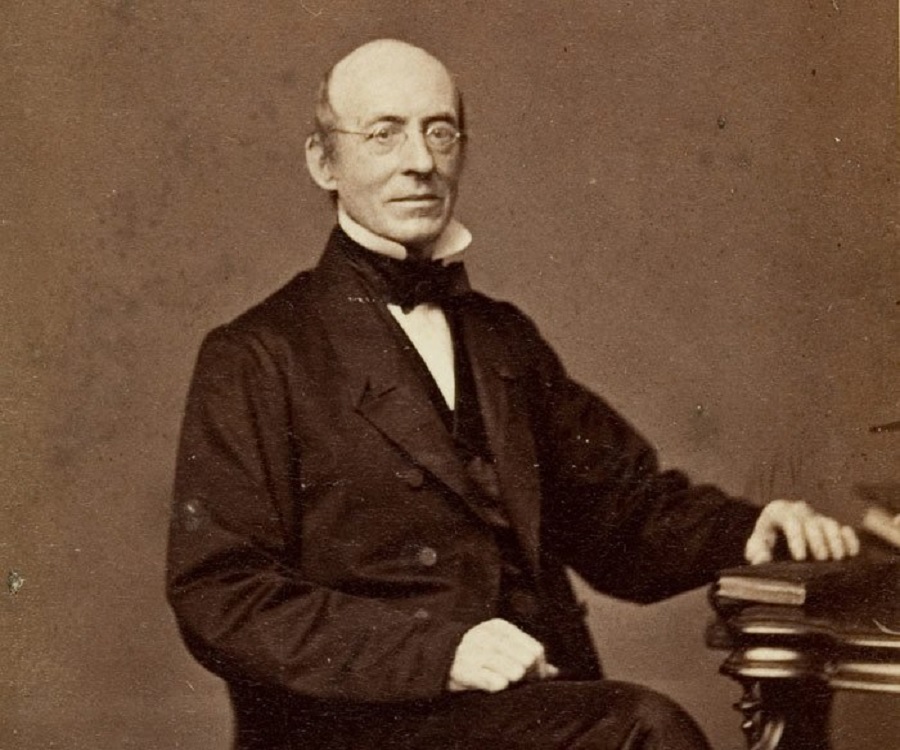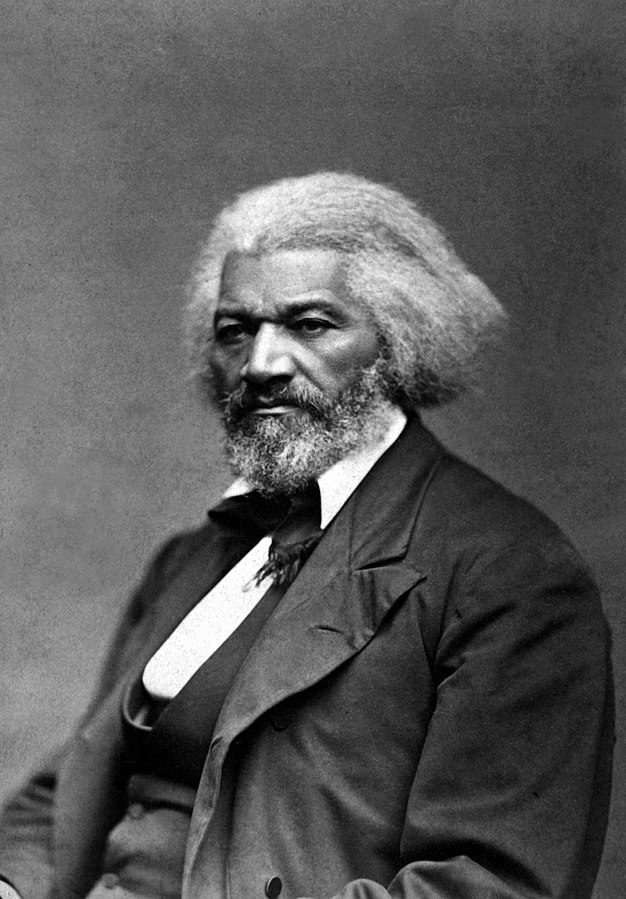Most “ethical vegans” (people who avoid animal products for moral reasons) would agree that the goal of the animal rights movement is the abolition of the use of animals for human purposes. In that sense, they are all “abolitionists.” The term abolitionist originates with the people who advocated for the abolition of slavery in the 18th and 19th centuries in North America and Britain. But to what extent can those who advocate the abolition of animal exploitation compare themselves to, and draw inspiration from, slavery abolitionists? Were their goals and tactics similar? Is there anything that can be learned from their failures and successes? I interviewed Dr. Wlodzimierz Gogloza to help us answer these questions. We’ll focus on the anti-slavery movement in North America.
Dr. Gogloza is an Assistant Professor of Law at the Maria Curie Sklodowska University in Lublin, Poland, where he teaches in the history of ideas, the legal traditions of the world and management studies. He has co-authored one book, co-edited seven scholarly volumes and published dozens of academic papers on various subjects, including the radical fringes of the American anti-slavery movement. He also volunteers for Open Cages/Anima International as a legal advisor and campaign coordinator.
Vegan Strategist: First of all, who were these nineteenth century slavery abolitionists? What actually defined them?
Dr. Gogloza: The first thing to understand is that within the North American anti-slavery movement, the so-called abolitionists were a minority. No more than 300,000 people identified themselves as abolitionists before the Civil War. The population of the United States at that time was around 31 million. Moreover, self-identified abolitionists were very scattered across the North: even in the northernmost states where the anti-slavery movement was strongest, there were just a few places where one in ten people were abolitionist.
Abolitionists were basically those who agreed with the three demands of the American Anti-Slavery Society (the main abolitionist group in the United States). The first demand was immediate abolition of human bondage (sometimes called “immediatism,” as opposed to gradualism). The second: no compensation whatsoever for slave owners and no forced emigration (“expatriation”) of former slaves. The third demand was for all former slaves to be granted civil rights. These three goals carried the same weight, and if someone rejected even one of them, they would not be considered abolitionists.
Some of the most influential and best-known American abolitionists include William Lloyd Garrison, Frederick Douglass, Angelina and Sarah Grimké, Abby Kelley Foster, Lucretia Mott, Wendell Phillips, Joshua Leavitt, and Charles Sumner. They did not always see eye to eye with one another on every question relating to abolition, especially on how the emancipation of slaves should be achieved, but they all agreed that the three above mentioned demands were non-negotiable.
Vegan Strategist: Those demands don’t seem too controversial in our present-day eyes…?
Dr. Gogloza: And yet they were extremely controversial at the time. It was especially the uncompromising anti-racist stance of their last demand that made the abolitionists seem like crazy fundamentalists.
Racism was much more widespread than it is today, and even among the anti-slavery activists, there were many people who harbored racist attitudes. The idea that the African-Americans should have the same rights as white citizens appalled even people who regarded slavery as an abomination.
President Lincoln, for instance, wanted to help slaves, but due to the stigma attached to the abolitionist movement, he tried hard to distance himself from the abolitionists. One man who campaigned for Abraham Lincoln in 1860 complained: “I have been denounced as impudent, foppish, immature, and worse than all, an abolitionist” (1).
Vegan Strategist: So within the broader anti-slavery movement, what would be the demands of those who didn’t belong to the abolitionist faction?
Dr. Gogloza: Some people were in favor of some kind of compensation for slaveholders, others wanted to send freed slaves to Africa. Lincoln, for instance, and Harriet Beecher Stowe, author of the seminal “Uncle Tom’s Cabin,” were proponents of the latter idea, known as colonization. Others still wanted to get rid of slavery in a more gradual fashion.
Vegan Strategist: Were there people who actually shared all the abolitionists’ ideas, but didn’t campaign for them for pragmatic reasons?
Dr. Gogloza: Many Quakers agreed with the abolitionists in principle, but refused to participate in the abolitionists’ activities, which they regarded as disruptive and unruly. Their stance was known as “Quietism.” There were also many people who were disturbed by some fringe views on government and organized religion that some very prominent members of the AASS held. William Lloyd Garrison and his supporters, known as Garrisonians, openly advocated for something approaching anarchism, and had a particularly polarizing influence on the broader anti-slavery movement.
Vegan Strategist: Some animal rights advocates, notably Gary Francione, who shaped the so-called “abolitionist approach,” and his followers, like to compare the fight for animal liberation to the fight of slavery abolitionists, seeing themselves in a similar position. What is it that they find especially inspiring?
Dr. Gogloza: I believe the modern day animal rights abolitionists, like Gary Francione and others, like the uncompromising and unequivocal stance of the slavery abolitionists. They seem also to be very fond of two tactics that they closely associate with the Garrisonians and other 19th-century immediatists: abstention and moral suasion. Here, as an example, is a representative quote from Gary Francione:
“Garrison was clear: If you oppose slavery, you stop participating in the institution. Period. You emancipate your slaves. You reject slavery and you aren’t ashamed of your opposition. You don’t try to hide it. You openly and sincerely, but nonviolently, express your ‘persistent, uncompromising moral opposition’ to slavery, which is ‘a system of boundless immorality.’
Similarly, if you believe that animal exploitation is wrong, the solution is not to support ‘happy’ exploitation. The solution is to go vegan, be clear about veganism as an unequivocal moral baseline, and to engage in creative, nonviolent vegan education to convince others not to participate in a system of ‘boundless immorality'” (2).
I strongly believe, however, that the parallels the animal rights abolitionists draw between their position and the position of 19th century slavery abolitionists are false, and are based on a very superficial understanding of the original abolitionist movement and the social and political reality in which it emerged.
Vegan Strategist: Let’s look at this “moral suasion” first. How important was this tactic to slavery abolitionists?
Dr. Gogloza: Moral suasion was a tactic the American Anti-Slavery Society employed in the 1830s to end slavery by appealing to the Christian conscience of slave-owners and convincing them that slaveholding was a great sin, and should be immediately abandoned. It was a religious tactic employed by what was, in essence, a religious movement.
The AASS came into existence on the wave of the so-called Second Great Awakening – a Protestant religious revival that swept the US during the first half of the 19th century. People associated with the Great Awakening emphasized the power of an individual to renounce sin and encouraged their fellow Christians to strive for personal holiness. Almost all early abolitionists came from this milieu. In fact, the AASS itself can be seen as a secular coalition of Quakers, Baptists, and Congregational revivalists, who wanted to inspire the slaveholders to renounce the sin of slavery and voluntarily free their slaves.
Vegan Strategist: What shape did this moral suasion take, in practice?
Dr. Gogloza: The tactic translated into a massive propaganda campaign. For almost two years, the AASS printed from twenty to fifty thousand anti-slavery pamphlets per week. They mailed these to slaveholders, state and federal government officials, politicians, newspaper editors, ministers, and preachers all over the country, but especially in the South. By the 1836, the abolitionists flooded the US with anti-slavery propaganda, sending more than one million pamphlets, posters, songbooks, and even readers for small children.
The abolitionists also sent their most engaging public speakers on lecture tours all around the North, held regular public meetings in major northern cities, and organized fairs, bazaars, and picnics, as well as vigils and prayer groups.
Vegan Strategist: How successful were these efforts?
Dr. Gogloza: All this required huge resources and thousands of activists, but the results were quite discouraging. While some slave owners did free their slaves, the vast majority of Southerners reacted to the abolitionists’ propaganda with extreme hostility, including mobs burning abolitionist mailings in post offices and violence against abolitionists, which resulted in several deaths. In the end, the campaign proved to be counterproductive. It actually hardened the slave owners’ commitment to slavery.
Vegan Strategist: How so?
Dr. Gogloza: After the Revolutionary War, many Southerners did believe that slavery was evil, though a necessary evil. By the early 1840s, this changed, and to many Southerners slavery had become – to quote a speech by senator Albert Gallatin Brown from Mississippi – “a great moral, social, and political blessing—a blessing to the slave, and a blessing to the master” (3). When in an infamous speech, John C. Calhoun insisted that “slavery was a positive good” (4), this was a direct result of the abolitionists’ postal campaign.
Vegan Strategist: Did the abolitionists realize that what they did wasn’t working?
Dr. Gogloza: They did. By the 1840’s, most of them had decided to abandon moral suasion as an outreach method. Two major tactics emerged at that time within the abolitionist movement. Some of the abolitionists started to focus on political campaigning, others on what modern scholars call “revolutionary abolitionism,” providing help to runaway slaves, disrupting the effectiveness of the Fugitive Slave Act, preparing for slave insurrection, etc.
The politically inclined abolitionists founded the Liberty Party, with the sole aim of making slavery illegal. The LP was not successful. Its best electoral outcome amounted to less than then 3% of the popular vote. But the abolitionist party later merged with the Free Soil Party, which quickly became a major political force in the North, and can be seen as a forerunner of Lincoln’s Republican Party.
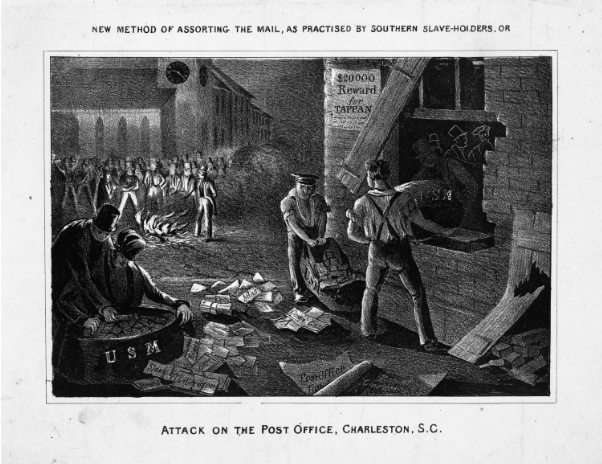
Southern slaveholders responded to abolitionist mail campaigns by overtaking post offices and burning mail. Image via Vegan Strategist.
Vegan Strategist: Were all abolitionists on board with political campaigning?
Dr. Gogloza: No. The Garrisonians especially were hostile towards any form of government and found political engagement both useless and immoral. Instead, they advocated disunion, the secession of the northern free states from the United States. The masthead of The Liberator, which was the major press organ of the Garrisonians, contained the famous slogan “No Union with the Slaveholders.” This was obviously an extremely controversial position which could not attract major support.
But the Garrisonians were also involved in more pragmatic efforts: they helped to establish unsegregated schools, churches, libraries, etc., and successfully campaigned against segregation in carriages, trains, and steamboats.
Vegan Strategist: What about abstention from slavery products? Did the 19th century abolitionists regard this as an unequivocal moral baseline and a true test of one’s commitment to the cause, as Gary Francione seems to imply?
Dr. Gogloza: The constitution of the AASS encouraged its members to give preference to products of free labor, but this doesn’t mean that the abolitionists saw abstention as a moral imperative.
Abstention was first used as a tactic by British abolitionists at the end of the 18th century. They used a minimalist “key-hole approach” to boycott, by focusing their efforts on a few carefully selected products. By boycotting slave-produced sugar and rum from the West Indies (the Caribbean islands), they wanted to put economic pressure on slave-dependent industries, and ultimately make slavery unprofitable. The economic goal was not achieved, but the boycott was instrumental in founding a mass movement of dedicated abolitionists who eventually brought slavery in Britain to an end.
While being inspired by the British example, the American abolitionists chose a more radical path. Starting in the 1830s, they set up dozens of organizations promoting abstention from all slave products. They also opened over 50 “free produce shops,” which exclusively sold products made without slave labor. Many of them were rather short lived, though.
Vegan Strategist: How much traction did this abstention gain among the broader public in the US?
Dr. Gogloza: It never attracted a mass following, even among those with anti-slavery convictions. Complete avoidance of slave labor products was much more challenging than just boycotting sugar or rum (what the British did). The supply of free produce was not sufficient to satisfy even the smallest demand, and free-produce shops regularly had to cope with inventory shortages. And, the quality of the products was usually low, while prices were too high for most whites and almost all free blacks.
In the end, the exclusive reliance on free produce required so much dedication to the cause that only the most committed abolitionists could maintain it, often to the detriment of focusing on other anti-slavery activities (5).
Vegan Strategist: It sounds like, much like in the vegan movement today, the impact and efficiency of personal purity was under discussion.
Dr. Gogloza: Exactly. The parallel goes even deeper. Abstention actually became a major issue of contention within the abolitionist movement. The Garrisonians, who had initially supported the free produce cause, later started to criticize it. They realized that, in practice, abstention diverted energy from the anti-slavery struggle by shifting the focus from activism to personal morality.
Analyzing the papers and newsletters produced by the advocates of abstention reveals the abstentionists’ growing focus on personal purity and on a “consciousness of sincerity and consistency, of possessing ‘clean hands,’ of having ‘no fellowship with the workers of iniquity’” (6). This obsession with “clean hands,” by the way, proved to be a major problem for the owners of the free-produce shops, who constantly had to reassure their clients that the products they were selling were free of slave labor.
Vegan Strategist: That all sounds quite familiar…
Dr. Gogloza: It does, doesn’t it. Eventually, the self-righteousness of the “abstentionists” became unbearable even to deeply religious abolitionists, who like Garrison, were striving for holiness in their own private lives. By the late 1840s, virtually all major figures within the anti-slavery movement had come to oppose “abstention” as a major tactics to create change. As a result, abstentionism in the 1850s came to be associated almost exclusively with a very small faction of Quakers.
So, contrary to what some modern day animal rights abolitionists seem to be implying, the abstention movement was very small, insignificant, and at odds with the broader anti-slavery movement.
Even at the anti-slavery fairs, not all of the products that were sold were free produce. The abolitionists justified their acts of buying and selling the products of slave labor with their commitment to the slaves’ cause. As William Lloyd Garrison explained during one debate with abstentionists, “who but the abolitionist is so well entitled to use the products of slave’s toil in whose behalf he is laboring?” (7)
So, if one were to interpret Garrison’s comments in the context of modern debates over veganism, his approach to abstention would be much closer to a position known as “moral offsetting” than to Francione’s “veganism as a moral imperative.”
Vegan Strategist: What do you mean by “moral offsetting”?
Dr. Gogloza: It’s an idea popularized within the Effective Altruism community by Scott Alexander of the Slate Star Codex fame. The gist of it is that you can offset some of your “shortcomings” by doing an appropriate good deed. Let’s say, for example, that you feel a moral obligation to be a vegan, but for some reason you cannot fully commit to veganism. So, you offset your “milk chocolate addiction” with a donation to an animal rights organization, which then uses it to fund campaigns aimed at ending factory farming of dairy cows.
Note, I’m not saying that “moral offsetting” is a proper approach; it’s just that it is closer to what Garrison was advocating with regard to abstention, than a “moral baseline.”
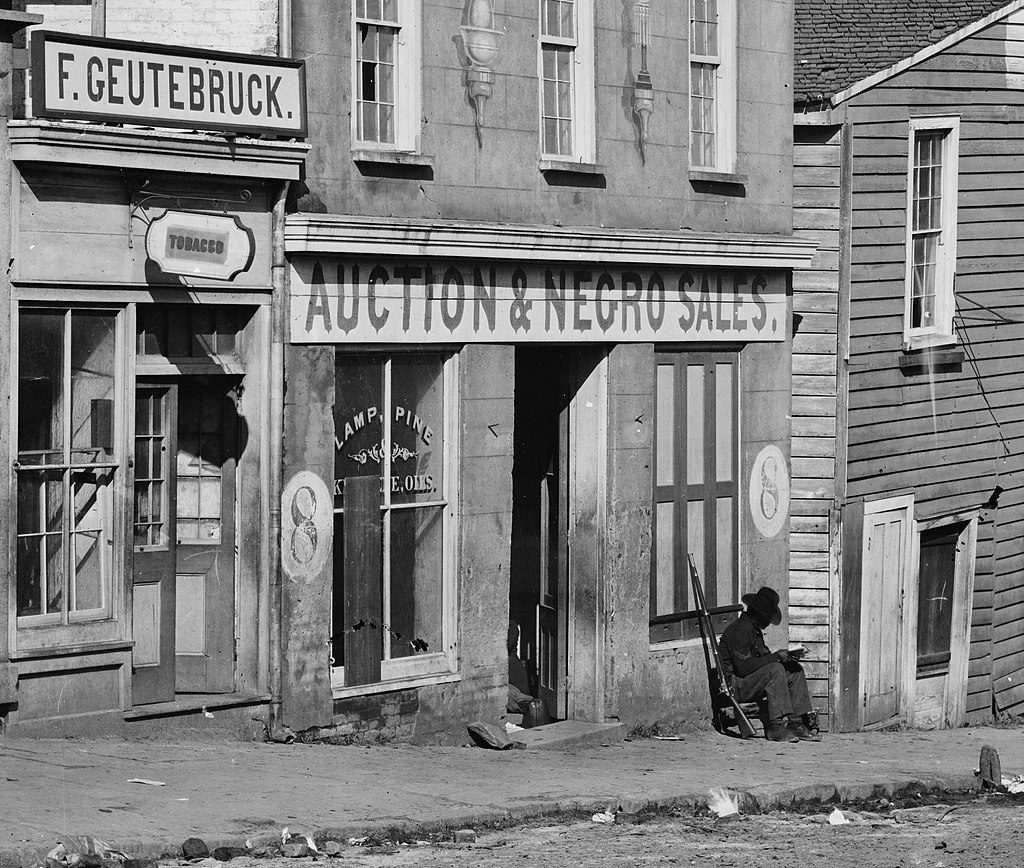
Slave trader’s business in Atlanta, Georgia, 1864. It’s important that people fighting for animal liberation understand the histories of other social movements without equating them with each other.
Vegan Strategist: As a vegan yourself, after having looked at the anti-slavery movement, in sum, what do you think are the major takeaways?
Dr. Gogloza: I’d say, first of all, make sure to really study the movements you claim to share affinity with and you think you’re taking advice from. The American abolitionist movement was not a monolith. It consisted of lot of different factions, which clashed almost constantly on both fundamental and minor issues pertaining to slavery and emancipation. There was no single one abolitionist tactic. The Garrisonians used one, the abstentionists another, and the political or constitutional abolitionists yet another. Sometimes, the factions did cooperate – for example on a petitioning campaign which however was quickly stifled by adoption of a gag rule by the US Congress – but it is inappropriate to talk about one abolitionist strategy or tactic.
Second, realize that the fact that a tactic worked at some point doesn’t imply universal applicability. The American abolitionists followed very closely in the footsteps of the British anti-slavery movement, and even though they tried similar approaches, they were not able to replicate British success, for a very obvious reason. The US was much more dependent on slavery than Britain, which meant that the American abolitionists operated in a different and much more challenging environment than the British ones.
Also, we should not become overly attached to one tactic, and be prepared to update our methods. The US anti-slavery movement was initially very attached to moral suasion, but then abandoned it and moved to institutional change. A similar thing happened with regard to abstention. When the abolitionists realized that the meager results of the boycott were barely worth the effort, the vast majority of them switched to different tactics.
Last but not least, we should acknowledge the limits of inspirational stories and personalities. I deeply admire the American abolitionists. It’s hard not to be inspired by their incredible courage, life-long commitment to the slaves’ cause, and pure guts necessary to challenge an institution so deeply engraved into the social, economic, and political system of their country. But, our heroes were not infallible (for example, the US abolitionists were an extremely quarrelsome bunch, and many of them were involved in bitter and prolonged personal feuds) and should not be expected to provide us with a blueprint to change the world, especially one which is so different from their own.
References:
1: O.L. Jackson, The Colonel’s Diary, Ohio 1922, p. 34.
2: G.L. Francione, The Abolitionist-Regulationist Debate From Another Era: Sound Familiar?
3: Quoted in J.M. McPherson, Battle Cry of Freedom. The American Civil War, New York 1990, p. 56
4: Speech on the Reception of Abolition Petitions, February, 1837, in J.C. Calhoun, Speeches of John C. Calhoun. Delivered in the Congress of the United States from 1811 to the present time, New York 1843, p. 225
5: R.K. Nuermberger, The Free Produce Movement: A Quaker Protest Against Slavery, Durham 1942.
6: E. Heyrick, Immediate, not Gradual Abolition: or, An Inquiry Into the Shortest, Safest, and Most Effectual Means of Getting Rid of West Indian Slavery, 2nd ed., Boston 1838, p. 35.
7: R.K. Nuermberger, op. cit., p. 102.
For a critical overview of the modern animal rights abolitionism, see L.E. Chiesa, Animal Rights Unraveled: Why Abolitionism Collapses into Welfarism and What It Means for Animal Ethics, “Georgetown Environmental Law Review”, Vol 28, 2016, pp. 557-587, available online.
Featured image: An advocate posting a flyer about going vegan. What lessons can animal advocates learn from the histories of other social movements? Image credit CALM action, CC BY-SA 3.0.

